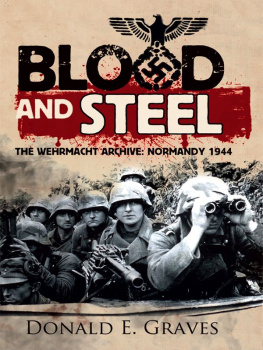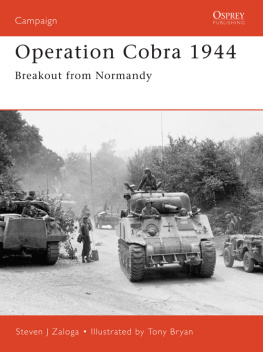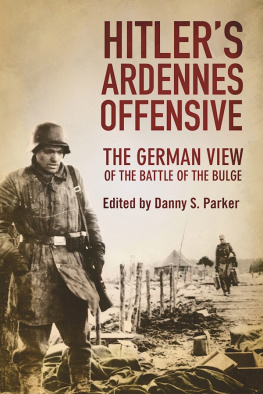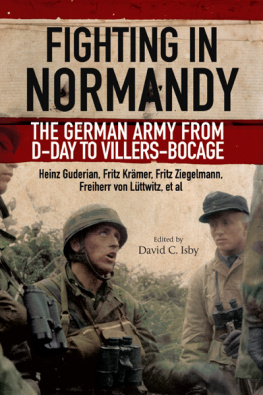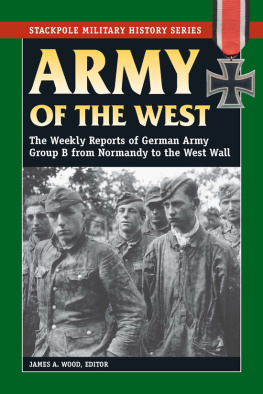FIGHTING THE
BREAKOUT
WORLD WAR II GERMAN DEBRIEFS
PUBLISHED BY GREENHILL BOOKS
THE BATTLE OF THE BULGE: THE GERMAN VIEW
Perspectives from Hitlers High Command
HITLERS ARDENNES OFFENSIVE
The German View of the Battle of the Bulge
INSIDE THE AFRIKA KORPS
The Crusader Battles, 19411942
THE GERMAN ARMY AT D-DAY
Fighting the Invasion
FIGHTING IN NORMANDY
The German Army from D-Day to Villers-Bocage
FIGHTING THE BOMBERS
The Luftwaffes Struggle Against the Allied Bomber Offensive
PANZERS ON THE EASTERN FRONT
General Erhard Raus and his Panzer Divisions in Russia, 19411945
FIGHTING THE
BREAKOUT
THE GERMAN ARMY IN NORMANDY FROM
COBRA TO THE FALAISE GAP
by
Generalmajor Rudolf-Christoph Freiherr von Gersdorff (Chief of Staff, German Seventh Army) and Generaloberst Paul Hausser (Commander-in-Chief, German Seventh Army)
with
General der Artillerie Wilhelm Fahrmacher, General der Panzertruppen Hans Eberbach and General Heinrich Freiherr von Luettwitz
Edited by David C. Isby
Frontline Books
Fighting the Breakout:
The German Army in Normandy from Cobra to the Falaise Gap
First published in 2004 by
Greenhill Books
published in this format in 2015 by
Frontline Books
an imprint of
Pen & Sword Books Ltd
47 Church Street, Barnsley, S70 2AS
www.frontline-books.com
Copyright David C. Isby
The right of David C. Isby to be identified as the author of this work has been asserted by him in accordance with the Copyright, Designs and Patents Act of 1988.
All rights reserved. No part of this publication may be reproduced, stored in or introduced into a retrieval system, or transmitted, in any form, or by any means (electronic, mechanical, photocopying, recording or otherwise) without the prior written permission of the publisher. Any person who does any unauthorized act in relation to this publication may be liable to criminal prosecution and civil claims for damages.
British Library Cataloguing in Publication Data
Fighting the breakout: the German Army in Normandy
from Cobra to the Falaise Gap
1. Germany. Heer History World War, 19391945
2. World War, 19391945 Campaigns France Normandy
3. World War, 19391945 Personal narratives, German
I. Luettwitz, Freiherr von
II. Isby, David C.
940.5'42142
ISBN 1-85367-584-9
Designed and typeset by Roger Chesneau
Printed and bound in Great Britain by
MPG Books Limited, Bodmin, Cornwall
Contents
by Generalmajor Rudolf-Christoph Freiherr von Gersdorff
by Generalmajor Rudolf-Christoph Freiherr von Gersdorff
by Generaloberst Paul Hausser
by General der Artillerie Wilhelm Fahrmacher
by Generaloberst Paul Hausser
by Generalmajor Rudolf-Christoph Freiherr von Gersdorff
by Generaloberst Paul Hausser
by Generaloberst Paul Hausser
by Generalmajor Rudolf-Christoph Freiherr von Gersdorff
by General der Panzertruppen Hans Eberbach
by Generalmajor Rudolf-Christoph Freiherr von Gersdorff
by Generaloberst Paul Hausser
by Generaloberst Paul Hausser
by General Heinrich Freiherr von Luettwitz (A-856)
by Generalmajor Rudolf-Christoph Freiherr von Gersdorff
Photographs
Maps
This volume is the narrative, from the viewpoint of some German generals, of the climax of the Normandy campaign, from the US breakout in Operation Cobra on 25 July to the near-destruction of the German forces in the Falaise Gap by 2021 August. Unlike the other collections of translated accounts concerning the German Army in Normandy and published by Greenhill, it is primarily the work of a single individual who had been one of the key participantsBaron von Gersdorff, who was then a colonel on the General Staff (Oberst i.G.), serving as Chief of Staff of the Seventh Army. His background as a thoroughly trained German staff officer is seen in his chapters, starting off with an estimate of the German situation, the Allied (enemy) situation, the terrain, and then a summary of the events.
Yet there is more to von Gersdorff than the summaries suggest. He had, in 1943, decided to act as a suicide bomber to kill Hider, but had not had the opportunity. He had links to the 20 July conspiracy against Hider, and throughout the operations described was in danger of arrest, torture, and summary execution. In attempting the break out through the Falaise Gap, he found himself to be a Panzer leader, in command of a small but extremely well-armed and desperate combined-arms Kampfgruppe.
Each of the chapters by von Gersdorff is paired with one from the man who was his boss throughout most of the events described. General Paul Hausser was Commander-in-Chief of the Seventh Army from 29 July. Different politically and personally from von Gersdorff, Hausser was considered the father of the Waffen SS, and his perceptions provide a contrast to the main narrative. Eberbachs chapter is included, in part, to provide greater depth regarding the activities of Fifth Panzer Army, on the British-Canadian front, whereas the focus of von Gersdorff and Hausser is primarily on the Seventh Army opposite the US forces.
While these documents are of great value, they must also be used with some care. They were written by participantsmany of whom never wrote their memoirs or other accounts in any languagewhose memories were still fresh, and their immediacy is not matched by attention to detail or their impartiality; for example, dates and locations are sometimes wrong or inconsistent. They were the first draft, not the last word, of the German assessment of the Normandy campaign. However, when compared with the German memoirs of the 1950s and 1960s that were translated into Englishworks which shaped the overall view of the war for many years, and which remain in printthese documents are no worse, and may be better.
These documents have been used as source material in all subsequent writing on Normandy, especially that in the English language. The potential value of a selection of these documents is suggested by their presence in the bibliographies of almost all the books that have appeared dealing with Normandy. They represent, together, a necessary source, but not a sufficient source.
The bottom line reached by the contributors to this book is not new or original. Because these accounts were the first postwar English language versions, and have been the most accessible to English-speaking historians, they have provided much of the accepted wisdom of the German view of Normandy. The authors had no knowledge of Ultra, nor that the Allies had become proficient at decrypting their radio communications. The view that the German defeat in Normandy reflected Allied material superiority, air superiority, and the interference by Hider and his favorite generals at high level became the standard presentation of the German view of their defeat for a generation. The significance of Allied airpower, both in the interdiction mission and over the battlefield, is repeated time and again in these documents. In part, it provides a palatable rationale for their defeat, allowing the authors to point at the absent Luftwaffe. That Allied material superiority should in the end prove decisive should not have come as a surprise to German officers, many of whom came of age at the first invention of the


